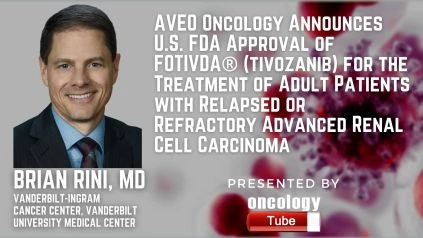Brian Rini, MD Professor of Medicine from Vanderbilt-Ingram Cancer Center, Vanderbilt University Medical Center speaks about AVEO Oncology Announces U.S. FDA Approval of FOTIVDA® (tivozanib) for the Treatment of Adult Patients with Relapsed or Refractory Advanced Renal Cell Carcinoma.
Link to Press Release:
https://investor.aveooncology.com/news-releases/news-release-details/aveo-oncology-announces-us-fda-approval-fotivdar-tivozanib
FOTIVDA was approved based on the results of AVEO’s pivotal Phase 3 trial, TIVO-3, which compared FOTIVDA to sorafenib in patients with relapsed or refractory advanced RCC who had received two or more prior systemic therapies. Three additional RCC trials back up the submission, which contains safety evidence from over 1,000 clinical trial participants.
Patients in the TIVO-3 study (n=350) were randomly assigned to obtain either FOTIVDA or sorafenib. Progression-free survival (PFS) was the primary efficacy outcome factor, which was determined by a blinded independent radiology review committee. Overall survival (OS) and objective response rate were two other efficacy endpoints (ORR).
The median PFS in the FOTIVDA arm (n=175) was 5.6 months (95 percent CI: 4.8, 7.3), compared to 3.9 months (95 percent CI: 3.7, 5.6) in the sorafenib arm (HR 0.73; 95 percent CI: 0.56, 0.95; p=0.016). The median OS for the FOTIVDA and sorafenib weapons was 16.4 months (95 percent CI: 13.4, 21.9) and 19.2 months (95 percent CI: 14.9, 24.2), respectively (HR 0.97; 95 percent CI: 0.75, 1.24). The ORR for the FOTIVDA arm was 18 percent (95 percent CI: 12 percent, 24 percent) and for the sorafenib arm was 8 percent (95 percent CI: 4 percent, 13 percent).
Fatigue, hypertension, diarrhea, reduced appetite, nausea, dysphonia, hypothyroidism, cough, and stomatitis were the most common (20%) adverse reactions. Decreased sodium, increased lipase, and decreased phosphate were the most common grade 3 or 4 laboratory abnormalities (5%).
The prescribed tivozanib dosage is 1.34 mg once daily with or without food for 21 days, followed by 7 days off treatment (28-day cycle) before disease progression or unacceptable toxicity.

